Organizational Behavior: Analyzing Conflict Types and Group Dynamics
VerifiedAdded on 2023/06/03
|7
|1701
|224
Essay
AI Summary
This essay delves into organizational behavior, specifically examining the impact of different types of conflicts—relationship, task, and process—on individual and group performance. It reviews an article by Jehn & Mannix (2001) that classifies work group conflict and discusses the limited research on process conflict. The essay proposes a new research question regarding the relationship between group atmosphere, conflict, and performance, suggesting further exploration using additional literature. It identifies gaps in the original article, such as the lack of examination of conflict patterns over time, and raises discussion points about how different conflict patterns influence group performance and organizational productivity. The essay also reflects on other studies related to personality traits, emotional experience, organizational structure, and organizational cultures, highlighting the importance of considering a wider range of factors and participants in future research and suggests that managers should encourage open discussions to ensure that conflicts reap productive outcomes and not destructive.
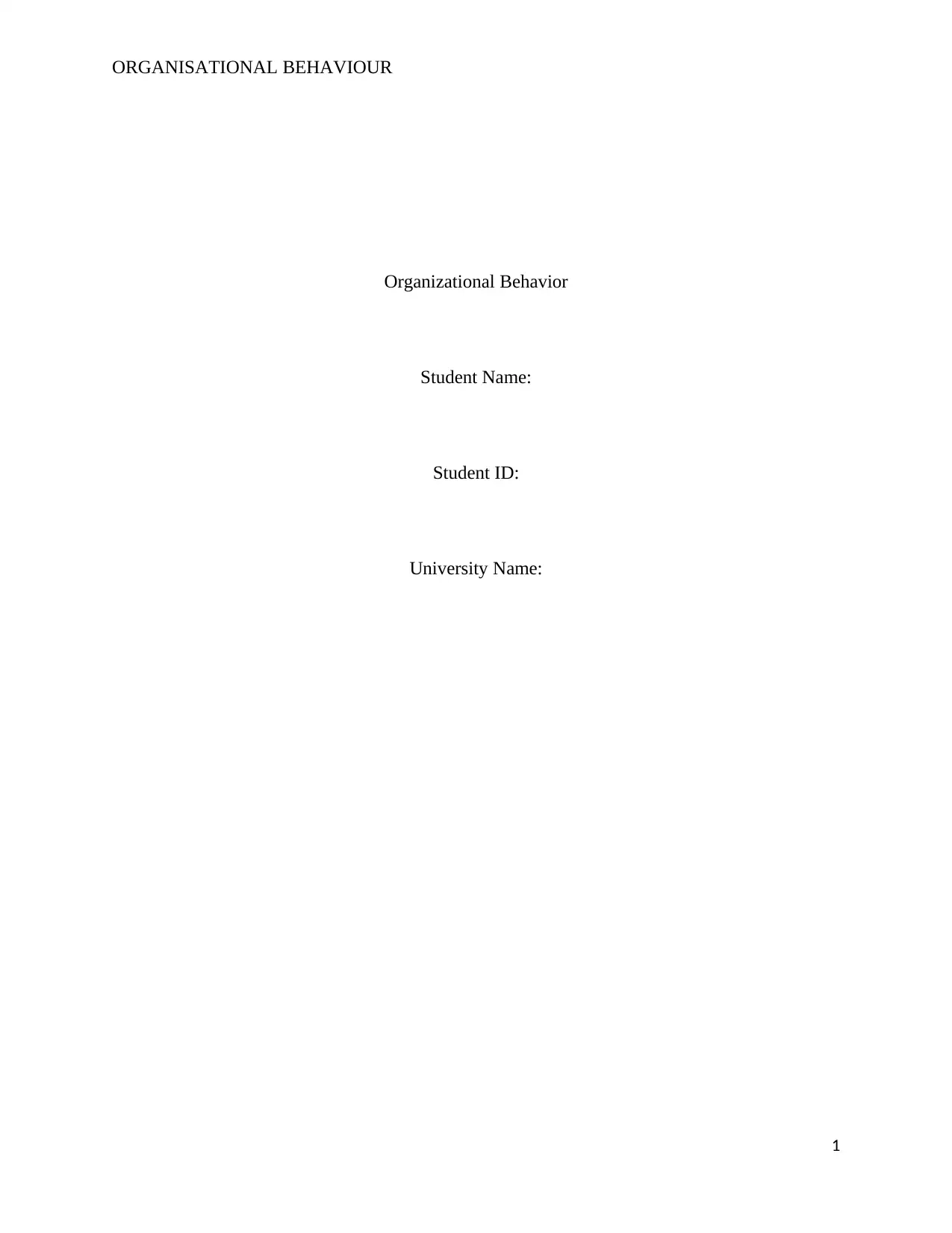
ORGANISATIONAL BEHAVIOUR
Organizational Behavior
Student Name:
Student ID:
University Name:
1
Organizational Behavior
Student Name:
Student ID:
University Name:
1
Paraphrase This Document
Need a fresh take? Get an instant paraphrase of this document with our AI Paraphraser
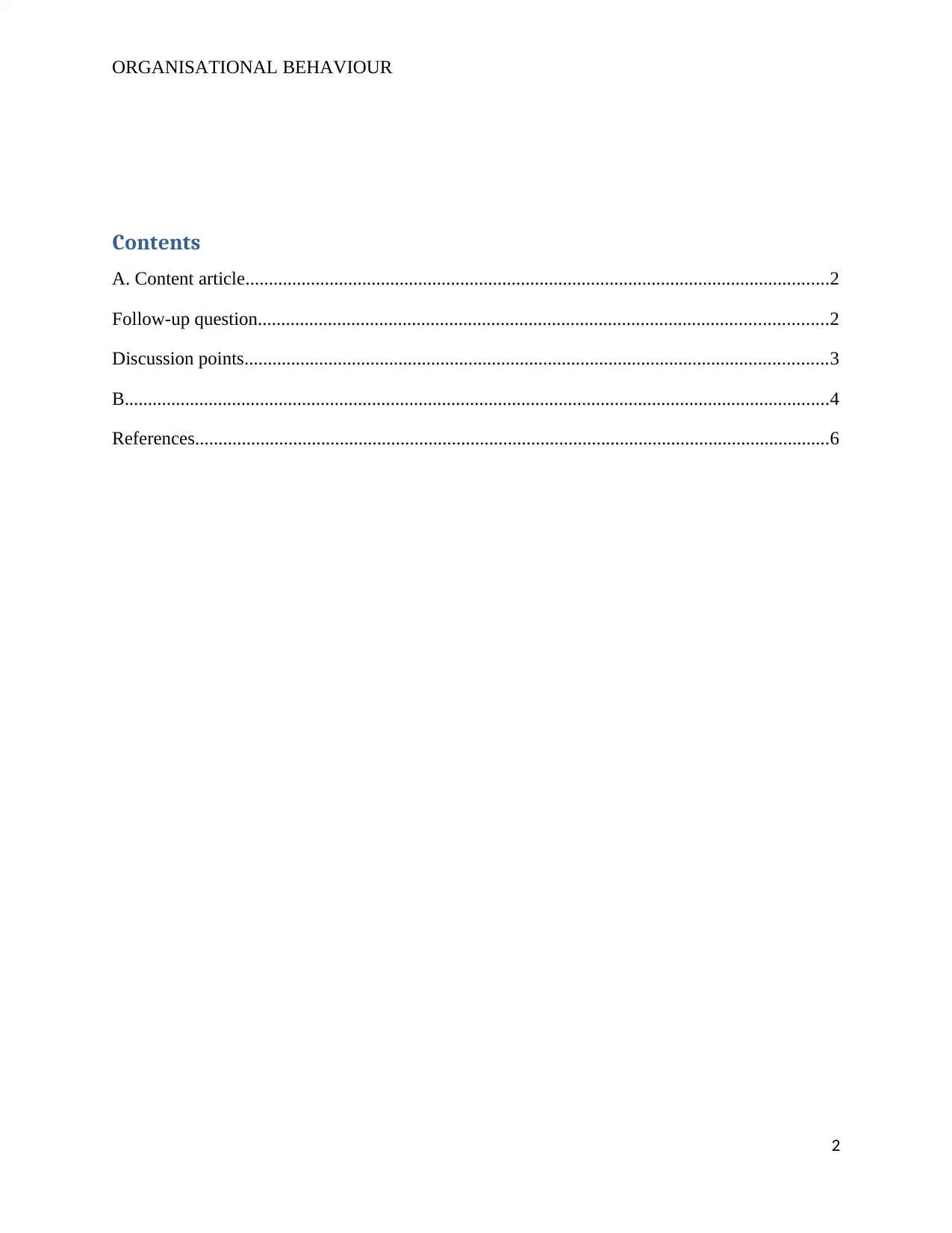
ORGANISATIONAL BEHAVIOUR
Contents
A. Content article.............................................................................................................................2
Follow-up question..........................................................................................................................2
Discussion points.............................................................................................................................3
B.......................................................................................................................................................4
References........................................................................................................................................6
2
Contents
A. Content article.............................................................................................................................2
Follow-up question..........................................................................................................................2
Discussion points.............................................................................................................................3
B.......................................................................................................................................................4
References........................................................................................................................................6
2
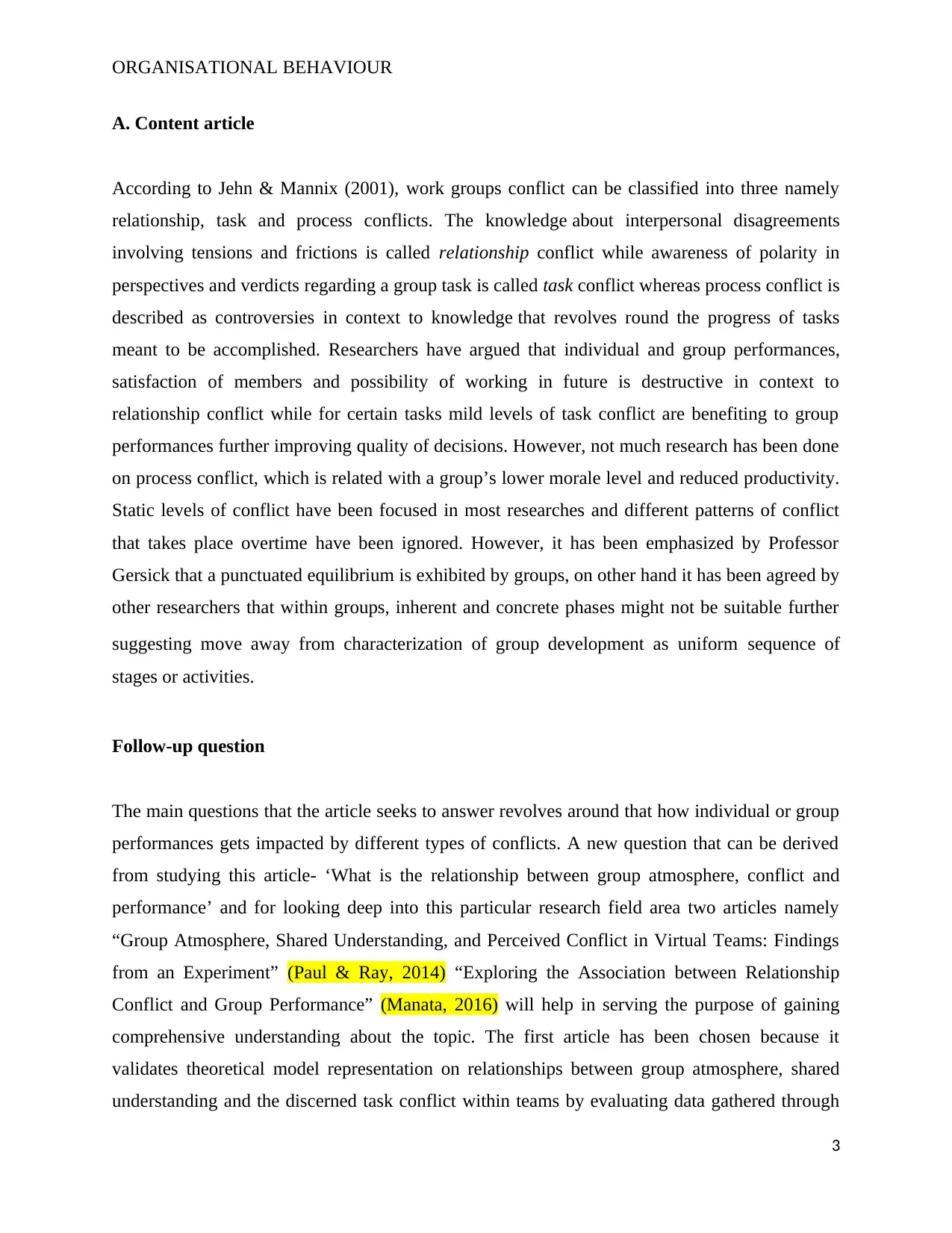
ORGANISATIONAL BEHAVIOUR
A. Content article
According to Jehn & Mannix (2001), work groups conflict can be classified into three namely
relationship, task and process conflicts. The knowledge about interpersonal disagreements
involving tensions and frictions is called relationship conflict while awareness of polarity in
perspectives and verdicts regarding a group task is called task conflict whereas process conflict is
described as controversies in context to knowledge that revolves round the progress of tasks
meant to be accomplished. Researchers have argued that individual and group performances,
satisfaction of members and possibility of working in future is destructive in context to
relationship conflict while for certain tasks mild levels of task conflict are benefiting to group
performances further improving quality of decisions. However, not much research has been done
on process conflict, which is related with a group’s lower morale level and reduced productivity.
Static levels of conflict have been focused in most researches and different patterns of conflict
that takes place overtime have been ignored. However, it has been emphasized by Professor
Gersick that a punctuated equilibrium is exhibited by groups, on other hand it has been agreed by
other researchers that within groups, inherent and concrete phases might not be suitable further
suggesting move away from characterization of group development as uniform sequence of
stages or activities.
Follow-up question
The main questions that the article seeks to answer revolves around that how individual or group
performances gets impacted by different types of conflicts. A new question that can be derived
from studying this article- ‘What is the relationship between group atmosphere, conflict and
performance’ and for looking deep into this particular research field area two articles namely
“Group Atmosphere, Shared Understanding, and Perceived Conflict in Virtual Teams: Findings
from an Experiment” (Paul & Ray, 2014) “Exploring the Association between Relationship
Conflict and Group Performance” (Manata, 2016) will help in serving the purpose of gaining
comprehensive understanding about the topic. The first article has been chosen because it
validates theoretical model representation on relationships between group atmosphere, shared
understanding and the discerned task conflict within teams by evaluating data gathered through
3
A. Content article
According to Jehn & Mannix (2001), work groups conflict can be classified into three namely
relationship, task and process conflicts. The knowledge about interpersonal disagreements
involving tensions and frictions is called relationship conflict while awareness of polarity in
perspectives and verdicts regarding a group task is called task conflict whereas process conflict is
described as controversies in context to knowledge that revolves round the progress of tasks
meant to be accomplished. Researchers have argued that individual and group performances,
satisfaction of members and possibility of working in future is destructive in context to
relationship conflict while for certain tasks mild levels of task conflict are benefiting to group
performances further improving quality of decisions. However, not much research has been done
on process conflict, which is related with a group’s lower morale level and reduced productivity.
Static levels of conflict have been focused in most researches and different patterns of conflict
that takes place overtime have been ignored. However, it has been emphasized by Professor
Gersick that a punctuated equilibrium is exhibited by groups, on other hand it has been agreed by
other researchers that within groups, inherent and concrete phases might not be suitable further
suggesting move away from characterization of group development as uniform sequence of
stages or activities.
Follow-up question
The main questions that the article seeks to answer revolves around that how individual or group
performances gets impacted by different types of conflicts. A new question that can be derived
from studying this article- ‘What is the relationship between group atmosphere, conflict and
performance’ and for looking deep into this particular research field area two articles namely
“Group Atmosphere, Shared Understanding, and Perceived Conflict in Virtual Teams: Findings
from an Experiment” (Paul & Ray, 2014) “Exploring the Association between Relationship
Conflict and Group Performance” (Manata, 2016) will help in serving the purpose of gaining
comprehensive understanding about the topic. The first article has been chosen because it
validates theoretical model representation on relationships between group atmosphere, shared
understanding and the discerned task conflict within teams by evaluating data gathered through
3
⊘ This is a preview!⊘
Do you want full access?
Subscribe today to unlock all pages.

Trusted by 1+ million students worldwide
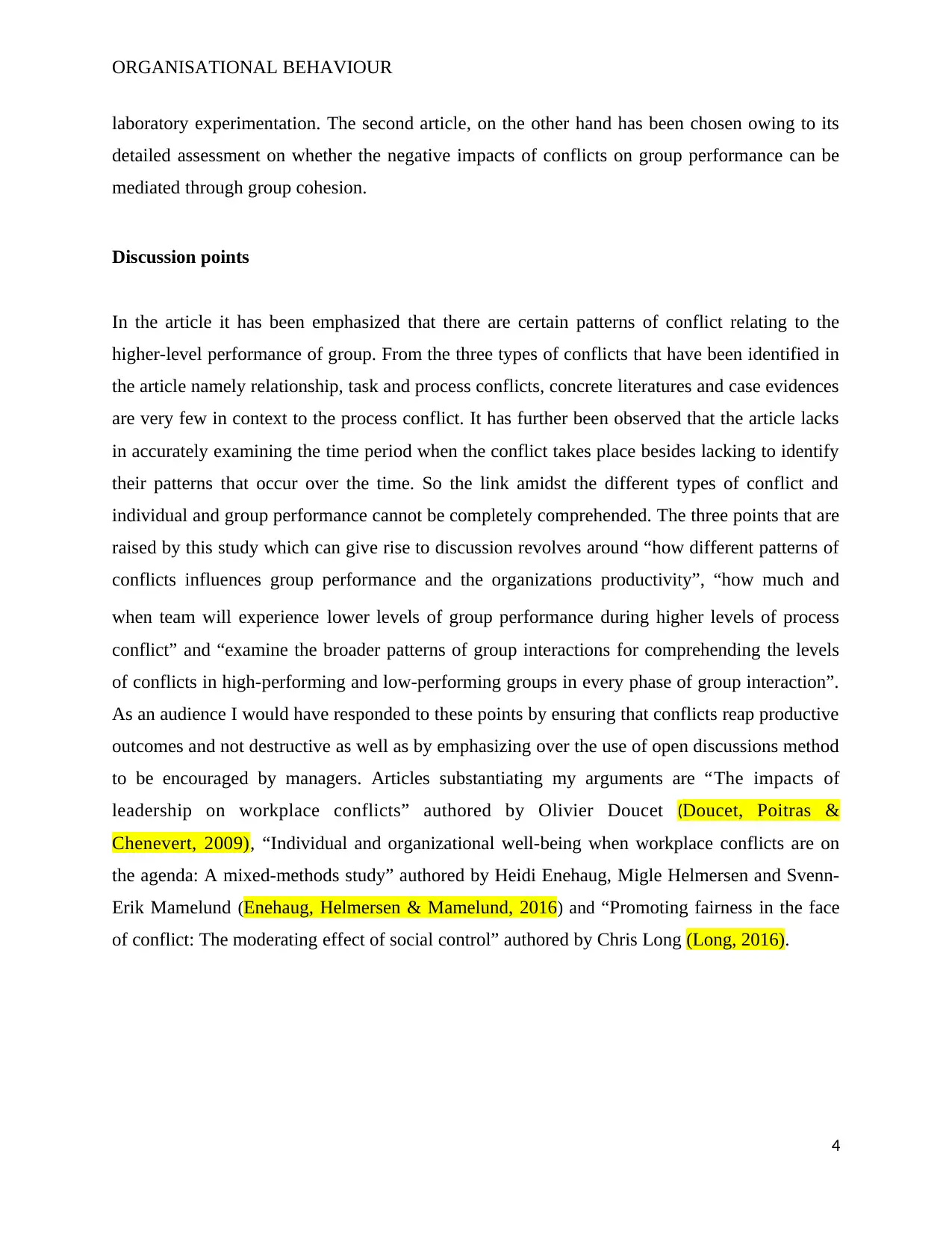
ORGANISATIONAL BEHAVIOUR
laboratory experimentation. The second article, on the other hand has been chosen owing to its
detailed assessment on whether the negative impacts of conflicts on group performance can be
mediated through group cohesion.
Discussion points
In the article it has been emphasized that there are certain patterns of conflict relating to the
higher-level performance of group. From the three types of conflicts that have been identified in
the article namely relationship, task and process conflicts, concrete literatures and case evidences
are very few in context to the process conflict. It has further been observed that the article lacks
in accurately examining the time period when the conflict takes place besides lacking to identify
their patterns that occur over the time. So the link amidst the different types of conflict and
individual and group performance cannot be completely comprehended. The three points that are
raised by this study which can give rise to discussion revolves around “how different patterns of
conflicts influences group performance and the organizations productivity”, “how much and
when team will experience lower levels of group performance during higher levels of process
conflict” and “examine the broader patterns of group interactions for comprehending the levels
of conflicts in high-performing and low-performing groups in every phase of group interaction”.
As an audience I would have responded to these points by ensuring that conflicts reap productive
outcomes and not destructive as well as by emphasizing over the use of open discussions method
to be encouraged by managers. Articles substantiating my arguments are “The impacts of
leadership on workplace conflicts” authored by Olivier Doucet (Doucet, Poitras &
Chenevert, 2009), “Individual and organizational well-being when workplace conflicts are on
the agenda: A mixed-methods study” authored by Heidi Enehaug, Migle Helmersen and Svenn-
Erik Mamelund (Enehaug, Helmersen & Mamelund, 2016) and “Promoting fairness in the face
of conflict: The moderating effect of social control” authored by Chris Long (Long, 2016).
4
laboratory experimentation. The second article, on the other hand has been chosen owing to its
detailed assessment on whether the negative impacts of conflicts on group performance can be
mediated through group cohesion.
Discussion points
In the article it has been emphasized that there are certain patterns of conflict relating to the
higher-level performance of group. From the three types of conflicts that have been identified in
the article namely relationship, task and process conflicts, concrete literatures and case evidences
are very few in context to the process conflict. It has further been observed that the article lacks
in accurately examining the time period when the conflict takes place besides lacking to identify
their patterns that occur over the time. So the link amidst the different types of conflict and
individual and group performance cannot be completely comprehended. The three points that are
raised by this study which can give rise to discussion revolves around “how different patterns of
conflicts influences group performance and the organizations productivity”, “how much and
when team will experience lower levels of group performance during higher levels of process
conflict” and “examine the broader patterns of group interactions for comprehending the levels
of conflicts in high-performing and low-performing groups in every phase of group interaction”.
As an audience I would have responded to these points by ensuring that conflicts reap productive
outcomes and not destructive as well as by emphasizing over the use of open discussions method
to be encouraged by managers. Articles substantiating my arguments are “The impacts of
leadership on workplace conflicts” authored by Olivier Doucet (Doucet, Poitras &
Chenevert, 2009), “Individual and organizational well-being when workplace conflicts are on
the agenda: A mixed-methods study” authored by Heidi Enehaug, Migle Helmersen and Svenn-
Erik Mamelund (Enehaug, Helmersen & Mamelund, 2016) and “Promoting fairness in the face
of conflict: The moderating effect of social control” authored by Chris Long (Long, 2016).
4
Paraphrase This Document
Need a fresh take? Get an instant paraphrase of this document with our AI Paraphraser
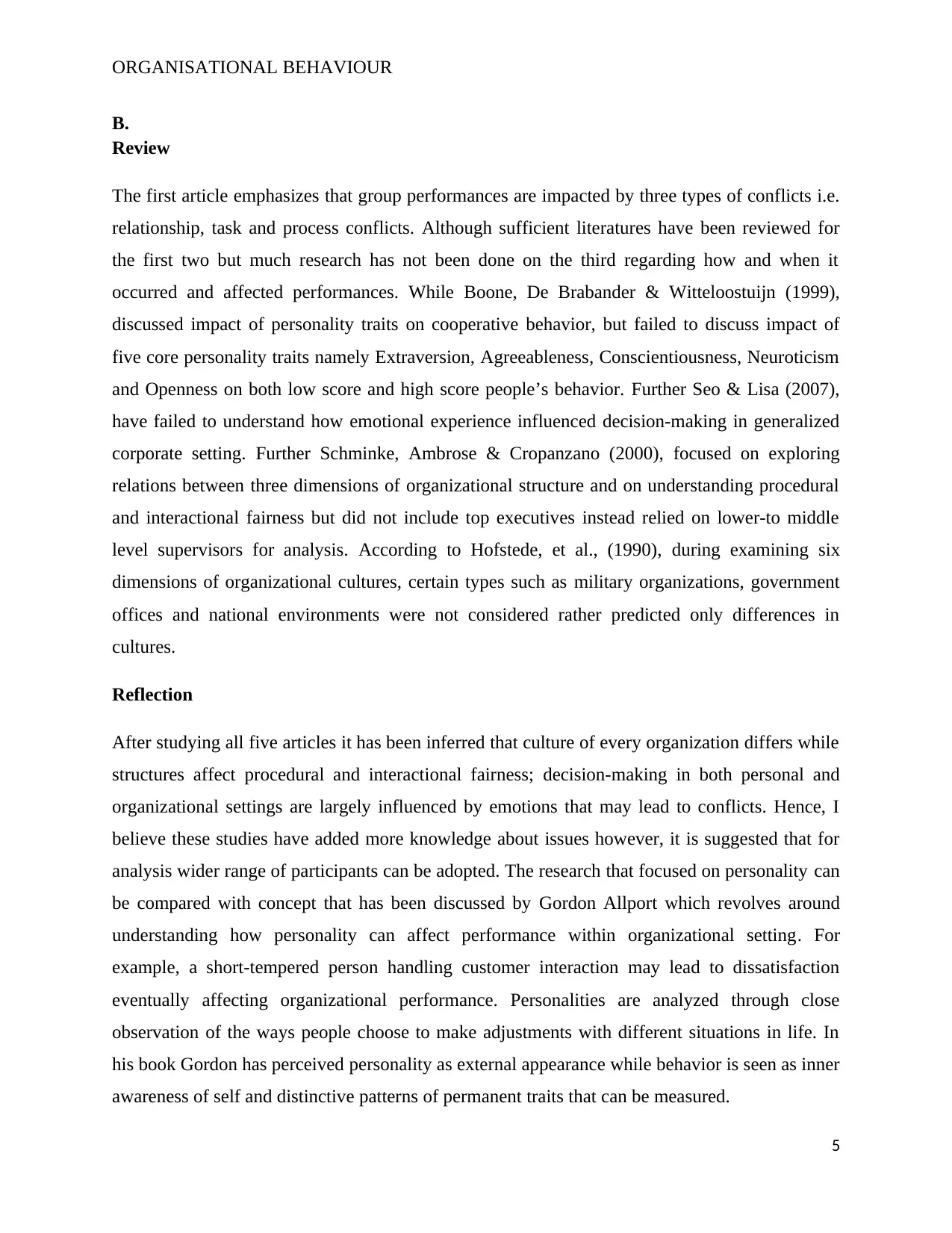
ORGANISATIONAL BEHAVIOUR
B.
Review
The first article emphasizes that group performances are impacted by three types of conflicts i.e.
relationship, task and process conflicts. Although sufficient literatures have been reviewed for
the first two but much research has not been done on the third regarding how and when it
occurred and affected performances. While Boone, De Brabander & Witteloostuijn (1999),
discussed impact of personality traits on cooperative behavior, but failed to discuss impact of
five core personality traits namely Extraversion, Agreeableness, Conscientiousness, Neuroticism
and Openness on both low score and high score people’s behavior. Further Seo & Lisa (2007),
have failed to understand how emotional experience influenced decision-making in generalized
corporate setting. Further Schminke, Ambrose & Cropanzano (2000), focused on exploring
relations between three dimensions of organizational structure and on understanding procedural
and interactional fairness but did not include top executives instead relied on lower-to middle
level supervisors for analysis. According to Hofstede, et al., (1990), during examining six
dimensions of organizational cultures, certain types such as military organizations, government
offices and national environments were not considered rather predicted only differences in
cultures.
Reflection
After studying all five articles it has been inferred that culture of every organization differs while
structures affect procedural and interactional fairness; decision-making in both personal and
organizational settings are largely influenced by emotions that may lead to conflicts. Hence, I
believe these studies have added more knowledge about issues however, it is suggested that for
analysis wider range of participants can be adopted. The research that focused on personality can
be compared with concept that has been discussed by Gordon Allport which revolves around
understanding how personality can affect performance within organizational setting. For
example, a short-tempered person handling customer interaction may lead to dissatisfaction
eventually affecting organizational performance. Personalities are analyzed through close
observation of the ways people choose to make adjustments with different situations in life. In
his book Gordon has perceived personality as external appearance while behavior is seen as inner
awareness of self and distinctive patterns of permanent traits that can be measured.
5
B.
Review
The first article emphasizes that group performances are impacted by three types of conflicts i.e.
relationship, task and process conflicts. Although sufficient literatures have been reviewed for
the first two but much research has not been done on the third regarding how and when it
occurred and affected performances. While Boone, De Brabander & Witteloostuijn (1999),
discussed impact of personality traits on cooperative behavior, but failed to discuss impact of
five core personality traits namely Extraversion, Agreeableness, Conscientiousness, Neuroticism
and Openness on both low score and high score people’s behavior. Further Seo & Lisa (2007),
have failed to understand how emotional experience influenced decision-making in generalized
corporate setting. Further Schminke, Ambrose & Cropanzano (2000), focused on exploring
relations between three dimensions of organizational structure and on understanding procedural
and interactional fairness but did not include top executives instead relied on lower-to middle
level supervisors for analysis. According to Hofstede, et al., (1990), during examining six
dimensions of organizational cultures, certain types such as military organizations, government
offices and national environments were not considered rather predicted only differences in
cultures.
Reflection
After studying all five articles it has been inferred that culture of every organization differs while
structures affect procedural and interactional fairness; decision-making in both personal and
organizational settings are largely influenced by emotions that may lead to conflicts. Hence, I
believe these studies have added more knowledge about issues however, it is suggested that for
analysis wider range of participants can be adopted. The research that focused on personality can
be compared with concept that has been discussed by Gordon Allport which revolves around
understanding how personality can affect performance within organizational setting. For
example, a short-tempered person handling customer interaction may lead to dissatisfaction
eventually affecting organizational performance. Personalities are analyzed through close
observation of the ways people choose to make adjustments with different situations in life. In
his book Gordon has perceived personality as external appearance while behavior is seen as inner
awareness of self and distinctive patterns of permanent traits that can be measured.
5
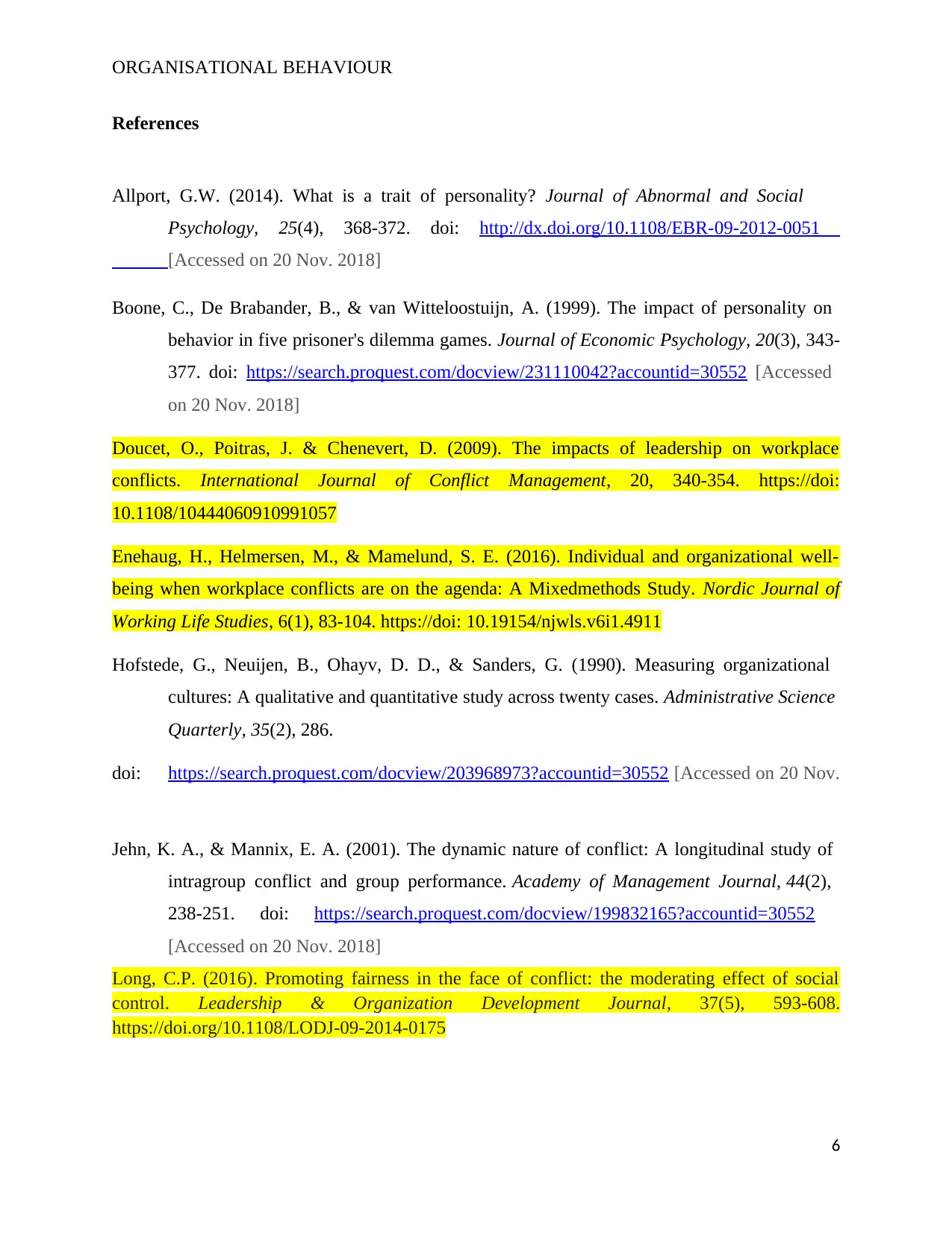
ORGANISATIONAL BEHAVIOUR
References
Allport, G.W. (2014). What is a trait of personality? Journal of Abnormal and Social
Psychology, 25(4), 368-372. doi: http://dx.doi.org/10.1108/EBR-09-2012-0051
[Accessed on 20 Nov. 2018]
Boone, C., De Brabander, B., & van Witteloostuijn, A. (1999). The impact of personality on
behavior in five prisoner's dilemma games. Journal of Economic Psychology, 20(3), 343-
377. doi: https://search.proquest.com/docview/231110042?accountid=30552 [Accessed
on 20 Nov. 2018]
Doucet, O., Poitras, J. & Chenevert, D. (2009). The impacts of leadership on workplace
conflicts. International Journal of Conflict Management, 20, 340-354. https://doi:
10.1108/10444060910991057
Enehaug, H., Helmersen, M., & Mamelund, S. E. (2016). Individual and organizational well-
being when workplace conflicts are on the agenda: A Mixedmethods Study. Nordic Journal of
Working Life Studies, 6(1), 83-104. https://doi: 10.19154/njwls.v6i1.4911
Hofstede, G., Neuijen, B., Ohayv, D. D., & Sanders, G. (1990). Measuring organizational
cultures: A qualitative and quantitative study across twenty cases. Administrative Science
Quarterly, 35(2), 286.
doi: https://search.proquest.com/docview/203968973?accountid=30552 [Accessed on 20 Nov.
Jehn, K. A., & Mannix, E. A. (2001). The dynamic nature of conflict: A longitudinal study of
intragroup conflict and group performance. Academy of Management Journal, 44(2),
238-251. doi: https://search.proquest.com/docview/199832165?accountid=30552
[Accessed on 20 Nov. 2018]
Long, C.P. (2016). Promoting fairness in the face of conflict: the moderating effect of social
control. Leadership & Organization Development Journal, 37(5), 593-608.
https://doi.org/10.1108/LODJ-09-2014-0175
6
References
Allport, G.W. (2014). What is a trait of personality? Journal of Abnormal and Social
Psychology, 25(4), 368-372. doi: http://dx.doi.org/10.1108/EBR-09-2012-0051
[Accessed on 20 Nov. 2018]
Boone, C., De Brabander, B., & van Witteloostuijn, A. (1999). The impact of personality on
behavior in five prisoner's dilemma games. Journal of Economic Psychology, 20(3), 343-
377. doi: https://search.proquest.com/docview/231110042?accountid=30552 [Accessed
on 20 Nov. 2018]
Doucet, O., Poitras, J. & Chenevert, D. (2009). The impacts of leadership on workplace
conflicts. International Journal of Conflict Management, 20, 340-354. https://doi:
10.1108/10444060910991057
Enehaug, H., Helmersen, M., & Mamelund, S. E. (2016). Individual and organizational well-
being when workplace conflicts are on the agenda: A Mixedmethods Study. Nordic Journal of
Working Life Studies, 6(1), 83-104. https://doi: 10.19154/njwls.v6i1.4911
Hofstede, G., Neuijen, B., Ohayv, D. D., & Sanders, G. (1990). Measuring organizational
cultures: A qualitative and quantitative study across twenty cases. Administrative Science
Quarterly, 35(2), 286.
doi: https://search.proquest.com/docview/203968973?accountid=30552 [Accessed on 20 Nov.
Jehn, K. A., & Mannix, E. A. (2001). The dynamic nature of conflict: A longitudinal study of
intragroup conflict and group performance. Academy of Management Journal, 44(2),
238-251. doi: https://search.proquest.com/docview/199832165?accountid=30552
[Accessed on 20 Nov. 2018]
Long, C.P. (2016). Promoting fairness in the face of conflict: the moderating effect of social
control. Leadership & Organization Development Journal, 37(5), 593-608.
https://doi.org/10.1108/LODJ-09-2014-0175
6
⊘ This is a preview!⊘
Do you want full access?
Subscribe today to unlock all pages.

Trusted by 1+ million students worldwide
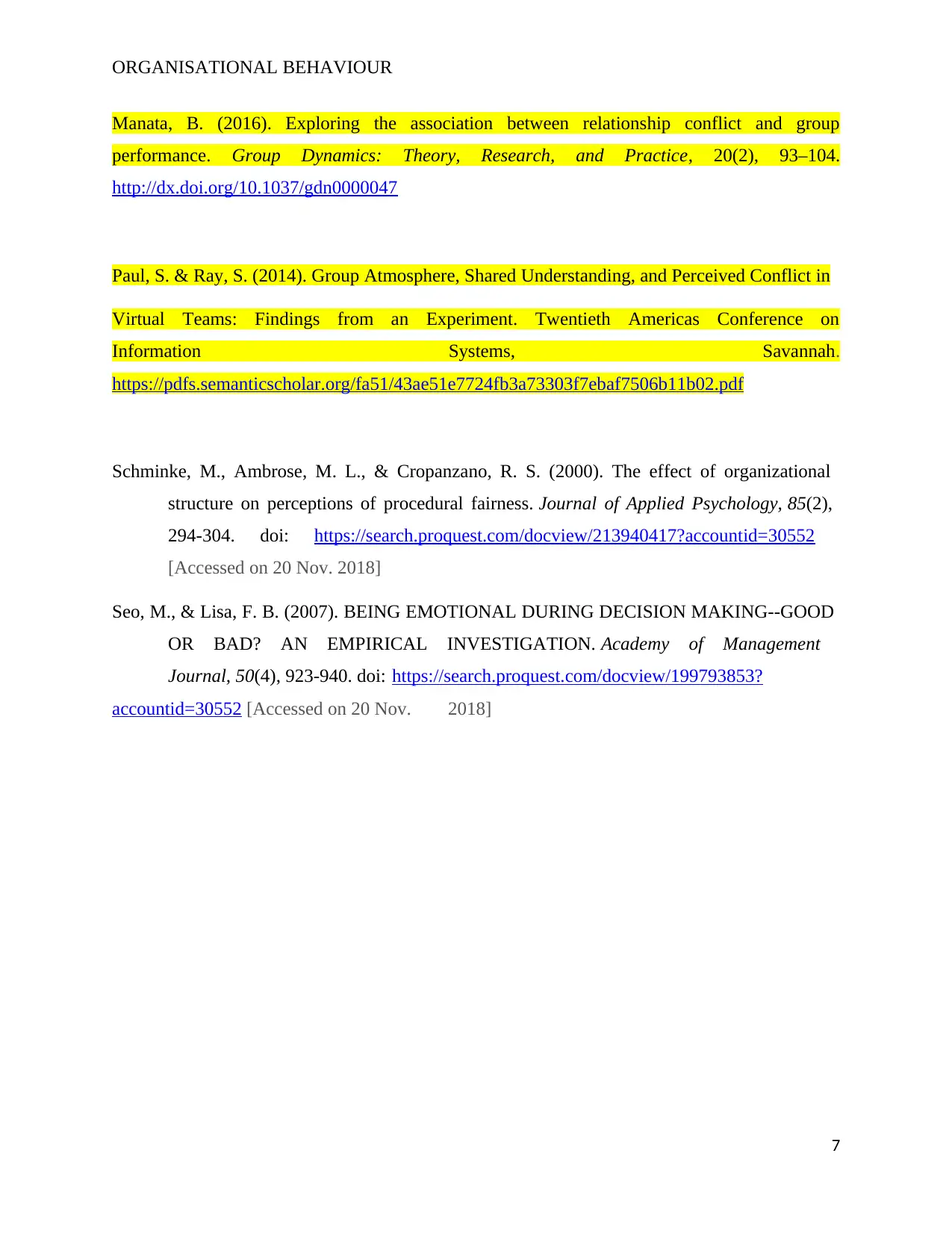
ORGANISATIONAL BEHAVIOUR
Manata, B. (2016). Exploring the association between relationship conflict and group
performance. Group Dynamics: Theory, Research, and Practice, 20(2), 93–104.
http://dx.doi.org/10.1037/gdn0000047
Paul, S. & Ray, S. (2014). Group Atmosphere, Shared Understanding, and Perceived Conflict in
Virtual Teams: Findings from an Experiment. Twentieth Americas Conference on
Information Systems, Savannah.
https://pdfs.semanticscholar.org/fa51/43ae51e7724fb3a73303f7ebaf7506b11b02.pdf
Schminke, M., Ambrose, M. L., & Cropanzano, R. S. (2000). The effect of organizational
structure on perceptions of procedural fairness. Journal of Applied Psychology, 85(2),
294-304. doi: https://search.proquest.com/docview/213940417?accountid=30552
[Accessed on 20 Nov. 2018]
Seo, M., & Lisa, F. B. (2007). BEING EMOTIONAL DURING DECISION MAKING--GOOD
OR BAD? AN EMPIRICAL INVESTIGATION. Academy of Management
Journal, 50(4), 923-940. doi: https://search.proquest.com/docview/199793853?
accountid=30552 [Accessed on 20 Nov. 2018]
7
Manata, B. (2016). Exploring the association between relationship conflict and group
performance. Group Dynamics: Theory, Research, and Practice, 20(2), 93–104.
http://dx.doi.org/10.1037/gdn0000047
Paul, S. & Ray, S. (2014). Group Atmosphere, Shared Understanding, and Perceived Conflict in
Virtual Teams: Findings from an Experiment. Twentieth Americas Conference on
Information Systems, Savannah.
https://pdfs.semanticscholar.org/fa51/43ae51e7724fb3a73303f7ebaf7506b11b02.pdf
Schminke, M., Ambrose, M. L., & Cropanzano, R. S. (2000). The effect of organizational
structure on perceptions of procedural fairness. Journal of Applied Psychology, 85(2),
294-304. doi: https://search.proquest.com/docview/213940417?accountid=30552
[Accessed on 20 Nov. 2018]
Seo, M., & Lisa, F. B. (2007). BEING EMOTIONAL DURING DECISION MAKING--GOOD
OR BAD? AN EMPIRICAL INVESTIGATION. Academy of Management
Journal, 50(4), 923-940. doi: https://search.proquest.com/docview/199793853?
accountid=30552 [Accessed on 20 Nov. 2018]
7
1 out of 7
Related Documents
Your All-in-One AI-Powered Toolkit for Academic Success.
+13062052269
info@desklib.com
Available 24*7 on WhatsApp / Email
![[object Object]](/_next/static/media/star-bottom.7253800d.svg)
Unlock your academic potential
Copyright © 2020–2025 A2Z Services. All Rights Reserved. Developed and managed by ZUCOL.





